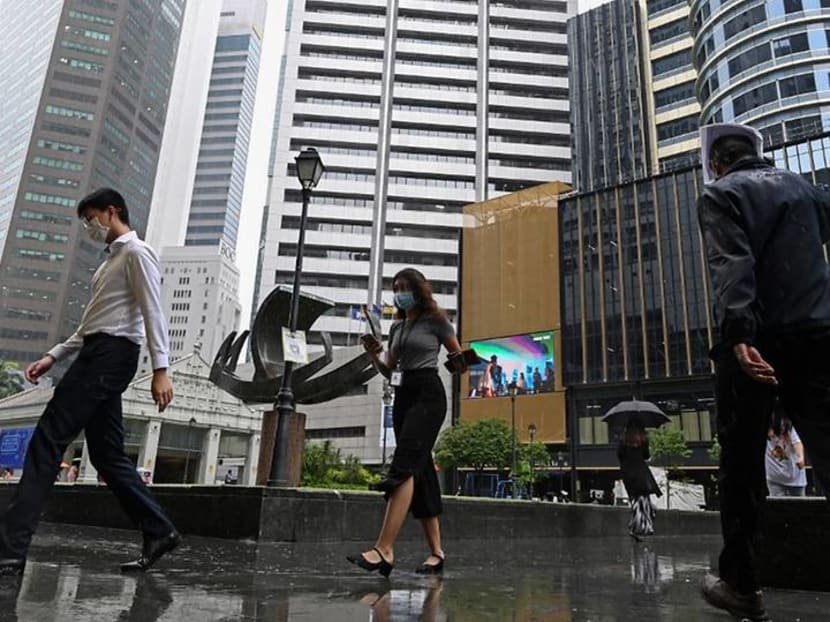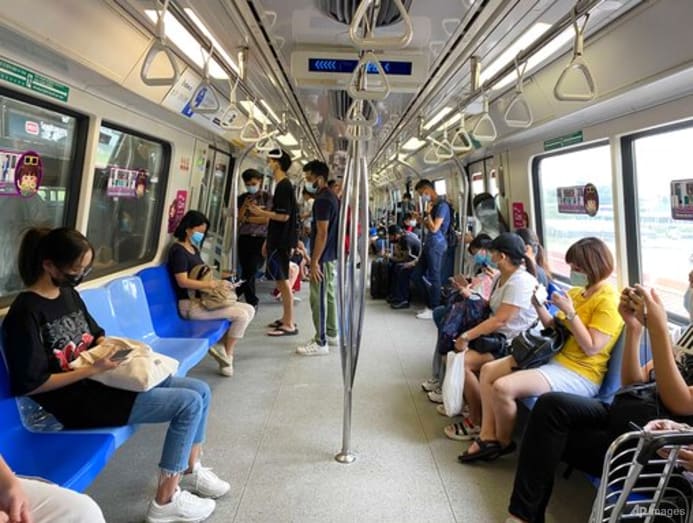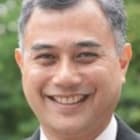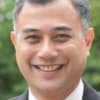Commentary: Singapore should focus on economic growth rather than redistributing a smaller pie as it reopens
Government assistance in 2020 and 2021 has put a floor beneath vulnerable sectors and families. But Singapore must focus on growing the economy as it reopens, says Faizal Yahya.

Workers in the Singapore central business district. (Photo: AFP/Roslan Rahman)
SINGAPORE: When Singapore was hit by the full brunt of the pandemic over 2020, the Government provided huge policy support measures for households and companies.
This not only prevented workers from being displaced but stopped growth-oriented companies from ceasing operations altogether.
This support has continued in sectors recovering at a slower pace such as aviation and the tourism industry.
In order to achieve this, Budget 2020 saw the roll out of four supplementary budgets in quick succession to tide the country over needed COVID-19 restrictions.
However, there are questions over the sustainability of such an approach given the Singapore economy’s contraction of 5.4 per cent in 2020.
Resorting to tapping on past reserves have also raised concerns over financing extra government expenditure. Despite stronger growth forecasts, the Government announced at Budget 2021 it will also draw S$1.7 billion more from the reserves.
THE PANDEMIC’S FOCUS ON HELPING THE BOTTOM
There is no doubt the extraordinary assistance has placed a floor beneath the lowest income households over this recession and saved many from destitution.
In February, Deputy Prime Minister Heng Swee Keat highlighted that income inequality measures in terms of the Gini coefficient in Singapore fell from 0.398 in 2019 to a historic low of 0.375 in 2020 due to “massive transfers” and schemes aimed towards supporting lower-income groups.
Such transfers took the form of continued subsidies to lower–income groups such as the Workfare Income Supplement (WIS) scheme, top-ups to earnings and CPF accounts, as well as one-off financial support for households experiencing a loss of income that tap on the COVID-19 Support Grant, not to mention waivers on HDB loans and support for charities.
Most of this increase in social expenditure has been funded by reliance on Net Investment Return Contributions (NIRC), Singapore’s largest revenue source that has exceeded all forms of taxes including the goods and services taxes (GST).

DILEMMA BETWEEN FOCUSING ON REDISTRIBUTION AND FOCUSING ON GROWTH
Nonetheless, some critics argue public policy should focus more on redistributive measures to help low-income families.
But how much is enough? In Singapore, the top 10 per cent of income earners contribute about 80 per cent of all personal income tax.
These are redistributed through schemes such as Workfare, GST vouchers, as well as ongoing subsidies for the lower and middle-income households in education, housing and healthcare among others.
As Ong Ye Kung highlighted in 2018 as Education Minister, low-income families (up to the 20th percentile) receive about S$4 in benefits for every dollar of tax that they pay. Middle-income families (from the 41st to 60th percentile) receive S$2 for every tax dollar.
This rate of distribution is higher that the S$1.3 to S$1.40 that middle-income households received for every tax dollar in the UK, US and Finland.
Moreover, any such redistributive focus should be balanced with an attendant focus on economic transformation and growth to expand revenue streams.
Given that the global economy is facing resurging rates of COVID-19 infections due to the Delta variant, Singapore’s growth prospects face strong headwinds and could be varied and unpredictable.
China’s growth forecasts have been slashed by investment banks last week. While US GDP growth rose at 6.5 per cent year-on-year in the second quarter, this came well below expectations.
In such an environment, wanting to have more to redistribute in the future requires our economy to ready our sails when the winds pick up, and enable every Singaporean to reach their fullest potential. We need to grow the pie so each portion can be bigger.
This is why Prime Minister Lee Hsien Loong’s National Day message focusing on inclusive growth is a useful one. His emphasis on supporting low-wage workers to reskill to seize new opportunities to achieve job progression and income wage strikes a pragmatic tone.
GOING DIGITAL THE MOST STRAIGHTFORWARD WAY TO BOOST GROWTH
In Singapore, the lingering adverse economic impact of COVID-19 coupled with maturing conditions that have slowed growth even before the pandemic, had thankfully resulted in earlier government policies to restructure the economy.
The challenge is transforming the economy to meet challenges of Industry 4.0 through digitalisation to create higher-value, higher-paying jobs.
It was fortuitous that the digitalisation drive started in earnest a few years before the pandemic because it enabled more businesses to work remotely and safely when firms had to make that overnight leap with the imposition of a circuit breaker last April.
Companies that embraced digitalisation were better prepared to source alternative revenue streams on e-commerce platforms, transform their business models to reduce operational costs and reach out overseas remotely to explore new market opportunities and trade collaborations.
(“I feel sad seeing my dining room empty ... But you must get over that to run the business and work in reality.” Summer Hill SG chef-owner Anthony Yeoh talks about fresh challenges these past 18 months on CNA's Heart of the Matter.)
Two in five who implemented digitalisation initiatives in 2020 experienced stronger revenue growth than non-adopters, a UOB study on small and medium enterprises released in March shows. Those who had digitalised their entire business or multiple areas reported stronger growth than those that went digital only in one area.
In contrast, six in 10 that did not adopt any digitalisation saw a decline in their 2020 revenues compared to a year before.
There is little wonder why when digitalisation can power trade-oriented Singapore SMEs’ search for new growth opportunities outside of our small domestic market and even reach consumers in Singapore, irrespective of whether COVID-19 restrictions come down.
BUT NEW BUG BEARS OF GOING DIGITAL HAVE EMERGED
However, the process of digitalisation has also raised concerns even as it has enabled work to continue – primarily over remote-working for knowledge workers.
More workers in Singapore have returned to work this past week. Firms know remote working has its limitations given the isolation, longer hours and inability to physically meet co-workers. A survey conducted by Microsoft in late 2020 found that Singapore workers topped the list in Asia facing increased burnout.
This same survey highlighted 37 per cent of respondents in Singapore citing a lack of separation between work duties and personal obligations impacting their well-being.
Authorities around the world have issued health advisories and provided resources for workers to manage stress over their work commitments. Calls for a four-day work week, a mental health day off and others advocating for a rebalancing of work and life have grown.
This concern over public health must be tackled. Companies must support knowledge workers better when strong morale is a prerequisite for a productive, innovative and resilient workforce.
The pandemic has already showed that economic activity and public health (social distancing) go hand in hand.
Our vaccination rates must stay high to reach “herd immunity” levels for Singapore to continue lifting curbs on economic activities like dining in, working in offices and safely open for foreign travel to grow the economy.
KEEPING THE ECONOMY GOING
One example of how government assistance has been critical to keeping warm specific strategic capabilities for when the pandemic blows over is this: Changi Airport staff have maintained our aviation hub running despite the wholesale collapse of air travel.
Being ready on the draw will put Singapore in a strong position. The winds are picking up when Singapore just announced on Thursday (Aug 19) the start of quarantine-free travel to Germany and Brunei for fully vaccinated travellers. Little wonder Singapore Airlines had prepared to increase its flight capacity in recent weeks.
There is no doubt our demographic and economic trends will require more spending for redistributive policies going forward but we need to balance this with economic growth as our economy transforms for a post COVID-19 scenario.
Singapore’s GDP growth forecast has been upgraded to 6 to 7 per cent last week, on the back of news that the economy rebounded in the second quarter of 2021 by 14.7 per cent.
We should ride on this positive momentum to grow our revenue streams. In a volatile and uncertain world, Singapore must shore up our reserves to be better prepared to meet the challenges of the next global crisis.
Dr Faizal Yahya is a Senior Research Fellow at the Institute of Policy Studies, Lee Kuan Yew School of Public Policy, National University of Singapore.














